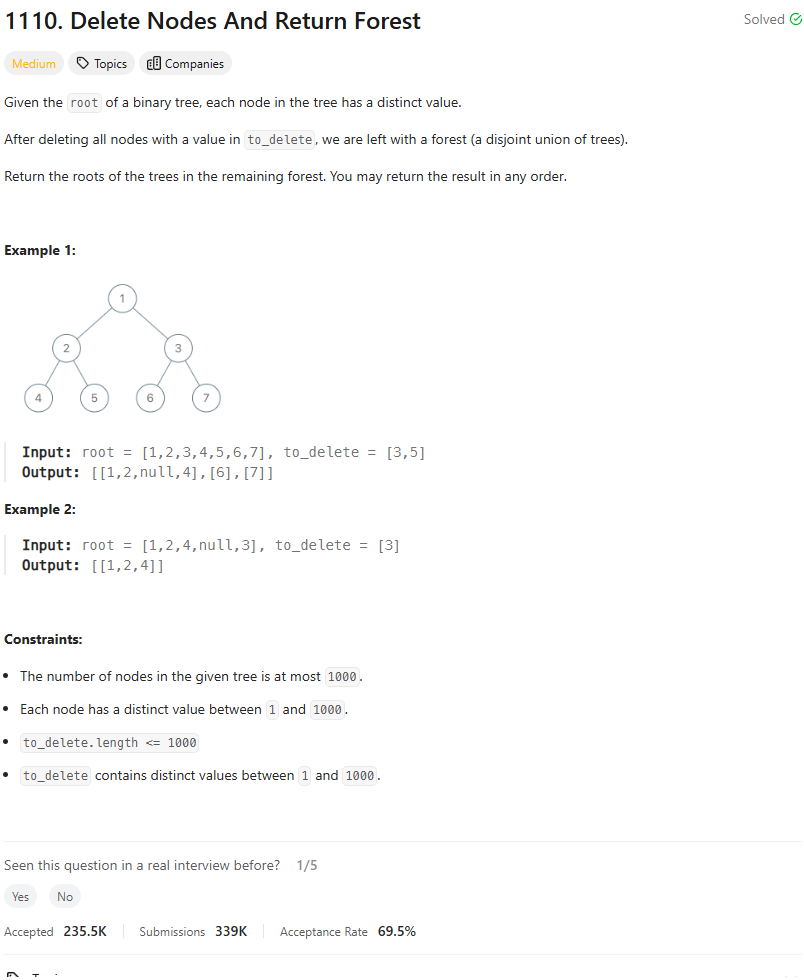Problem of The Day: Delete Nodes And Return Forest
Problem Statement

Intuition
I believe the problem can be approached using a depth-first search (DFS) traversal. By recursively visiting each node, I can determine whether it should be deleted and manage the connections to its children accordingly. If a node is marked for deletion, its children (if they are not also marked for deletion) should become new roots in the resulting forest.
Approach
- Initial Setup: I’ll start by checking if the root itself should be deleted. If not, I’ll add it to the result list.
- Depth-First Search (DFS): Using DFS, I’ll traverse the tree and handle the deletion process:
- If a node is in the
to_deletelist, I’ll check its children. Any child not into_deletewill be added to the result list. - I’ll also break the link between the parent and the node marked for deletion.
- If a node is in the
- Return the Result: After the DFS traversal, the result list will contain all the new roots of the remaining trees.
Complexity
- Time Complexity: (O(n)), where (n) is the number of nodes in the tree. Each node is visited once.
- Space Complexity: (O(n)), due to the recursion stack in the worst case and the space needed for the result list.
Code
# Definition for a binary tree node.
# class TreeNode:
# def __init__(self, val=0, left=None, right=None):
# self.val = val
# self.left = left
# self.right = right
class Solution:
def delNodes(self, root: Optional[TreeNode], to_delete: List[int]) -> List[TreeNode]:
res = [root] if root and root.val not in to_delete else []
def dfs(node, parent):
if not node:
return
dfs(node.left, node)
dfs(node.right, node)
if node.val in to_delete:
if node.left and node.left.val not in to_delete:
res.append(node.left)
if node.right and node.right.val not in to_delete:
res.append(node.right)
if parent and parent.left is node:
parent.left = None
if parent and parent.right is node:
parent.right = None
dfs(root, None)
return res
Editorial
Approach 1: Recursion (Postorder Traversal)
class Solution:
def delNodes(
self, root: Optional[TreeNode], to_delete: List[int]
) -> List[TreeNode]:
to_delete_set = set(to_delete)
forest = []
root = self._process_node(root, to_delete_set, forest)
# If the root is not deleted, add it to the forest
if root:
forest.append(root)
return forest
def _process_node(
self, node: TreeNode, to_delete_set: Set[int], forest: List[TreeNode]
) -> TreeNode:
if not node:
return None
node.left = self._process_node(node.left, to_delete_set, forest)
node.right = self._process_node(node.right, to_delete_set, forest)
# Node Evaluation: Check if the current node needs to be deleted
if node.val in to_delete_set:
# If the node has left or right children, add them to the forest
if node.left:
forest.append(node.left)
if node.right:
forest.append(node.right)
# Delete the current node by returning None to its parent
return None
return node
Approach 2: BFS Forest Formation
class Solution:
def delNodes(
self, root: Optional[TreeNode], to_delete: List[int]
) -> List[TreeNode]:
if not root:
return []
to_delete_set = set(to_delete)
forest = []
nodes_queue = deque([root])
while nodes_queue:
current_node = nodes_queue.popleft()
if current_node.left:
nodes_queue.append(current_node.left)
# Disconnect the left child if it needs to be deleted
if current_node.left.val in to_delete_set:
current_node.left = None
if current_node.right:
nodes_queue.append(current_node.right)
# Disconnect the right child if it needs to be deleted
if current_node.right.val in to_delete_set:
current_node.right = None
# If the current node needs to be deleted, add its non-null children to the forest
if current_node.val in to_delete_set:
if current_node.left:
forest.append(current_node.left)
if current_node.right:
forest.append(current_node.right)
# Ensure the root is added to the forest if it is not to be deleted
if root.val not in to_delete_set:
forest.append(root)
return forest